What is a chatbot?
A chatbot is a customer service solution that provides automated responses to customer queries through preconfigured chat flows. Sophisticated chatbots are equipped with artificial intelligence (AI) and natural language processing (NLP) to simulate natural conversations with customers and keep up the engagement rate. Chatbots can be deployed on multiple customer service channels — like messaging apps, websites, mobile applications and voice assistants.
An efficient chatbot can understand and respond to real-time customer queries in a near-human tone and provide relevant resolutions under minimal supervision. You can also optimize chatbots to achieve set objectives like collecting customer data and feedback or delivering personalized customer service.
Why are chatbots important?
Chatbots have earned an irreplaceable position in optimizing customer service operations and reducing its complexity for businesses, employees and customers alike. For businesses, chatbots automate customer service, reducing costs and providing 24/7 availability. They enable instant responses to customers and personalized recommendations — ultimately increasing customer satisfaction and loyalty.
Employees benefit from chatbots as they streamline internal processes, handling routine tasks like HR inquiries or IT support independently. Customers, on the other hand, enjoy quick resolutions to their queries and an enhanced digital customer experience — leading to improved convenience and engagement.
How do chatbots work?
As the popularity of chatbots grows, businesses all over the world and across domains have started adopting chatbots to improve customer support and experience. Here’s a quick gist of what goes on inside a chatbot when a user posts a query or concern, and how it answers these queries effectively.
Collect user input: When the user sends a question or issue, the chatbot first receives it through any of the supported platforms/channels — a website, app or social media platform, or even any other channel where the chatbot is integrated such as community forums. In the case of voice-enabled chatbots or voicebots, the input is received through a phone call.
Understand input using natural language processing: With advanced AI-based algorithms like natural language processing (NLP) and natural language understanding (NLU), the chatbot then processes the user’s query. Critical checks like sentiment analysis and intent analysis are done by the chatbot, while also analyzing the customer’s interaction history to provide a highly contextual response.
Draft a response to the query/issue: Once the chatbot understands the message fully, it employs a predefined set of rules to formulate a suitable response. These responses are based on patterns and data the chatbot has been trained on. If the chatbot is AI-powered, it uses machine learning algorithms to create and draft replies, and continuously learns from each interaction to improve its future responses.
Sometimes, the chatbot also generates a set of responses and then decides the best option from them, for example, when there are multiple ways to resolve an issue. This approach helps in analyzing all possible resolution options before providing them to ensure the quickest, most efficient resolution possible.Send the response to the user: The chatbot then sends the response to the user, completing the interaction. The system then waits for the next response or sends a quick customer survey to rate the interaction, collect feedback and continuously improve the quality of conversations.
Chatbots operate on this very cycle, engaging in dynamic and conversational interactions over and over while also improving their tone and accuracy with every interaction. They aim to provide timely, contextually appropriate responses in a conversational tone that ensures a highly satisfying customer service experience.
Benefits of using chatbots
Using chatbot technology, businesses can provide 24/7 customer support for simple queries that do not require an agent’s immediate attention. Here are some major benefits of chatbots.
Benefits to customer support teams
Chatbots have become an indispensable part of customer service operations, since they enable extensive automation in providing quick responses and resolutions — and in turn, improving the overall efficiency of customer support teams. Below are some of the major benefits of chatbots for support teams.
1. Increased customer engagement
When customers begin a chat with support, chatbots can respond in real time — regardless of your agent’s availability.
Chatbots can interact with multiple customers simultaneously and reduce the burden on your support team while improving your customer engagement.
Chatbots can answer almost 80% of all standard questions.
IBM
2. Improved sales
Chatbots are smart. Driven by advanced algorithms and powered by AI, chatbots can understand your customers’ queries and share relevant responses. After consistent data analysis, chatbots can uncover cross-sell and upsell opportunities by introducing your products to customers.

Learn more: Why chatbots are needed in call centers?
3. Cost savings
You can optimize chatbots to handle complex queries and ensure seamless support across customer touchpoints.
As a chatbot evolves, it trains itself on gathered customer data and can provide more accurate and tailored solutions to the most common queries. Chatbots can also cut down live agents’ interaction time by sharing only those queries that require their attention, saving precious time and resources.
4. Automated processes
A well-constructed chatbot can automate the support process to a large extent. You can provide customers with self-service options, collect interaction feedback and submit support tickets all without any agent intervention — thereby improving your support team’s efficiency.
Learn more: AI Automation for Customer Service Agents
5. Multilingual support
Your customers can hail from across the globe. Some may be proficient in English but not in Chinese. Advanced chatbots can interact with customers in their native language and even translate their responses for your agents. This way, your support teams can resolve customer queries from numerous locations seamlessly.
Benefits to customers
Chatbots have quickly become one of the most popular and preferred customer service channels among customers — and there are quite a few solid reasons behind it. Below are some of the benefits that chatbots provide, that explain why chatbots are highly preferred by modern customers.
1. Quick responses
Modern customers hate to wait and expect brands to provide quick responses — making it essential for support teams to be much quicker with their responses and resolutions. Chatbots can interact with thousands of customers simultaneously, with everyone receiving personalized responses that focus on leading them to a solution. Quick, focused responses like these improve your first contact resolution (FCR) rate.
Learn more: Improve Customer Response Times and Your Bottom Line
2. Around-the-clock support
It’s natural for customers to expect their preferred brands to be available 24/7, which is challenging for agents due to their fixed working hours. Chatbots do not have such limitations — they are available around the clock to provide immediate support and streamline communications to minimize wait times and frustrations.
3. Personalized attention
Chatbot technology can store data related to the customer (e.g., name, email, ticket number) and their chat history to deliver a personalized experience across channels.
Customers grow impatient when they have to explain their problems multiple times to agents, resulting in a dissatisfied customer experience — 96% of customers will leave you for bad customer service. That’s where chatbots help you retain your customers.
Also, personalization helps you avoid the artificial, robotic voice that chatbots usually tend to have since you already know the users’ preferences — which provides an empathetic tone to your automated messages. With advanced conversational AI-powered chatbot solutions, you can even customize the “voice” of your chatbot based on individual customer preferences — to deliver highly interactive support conversations.
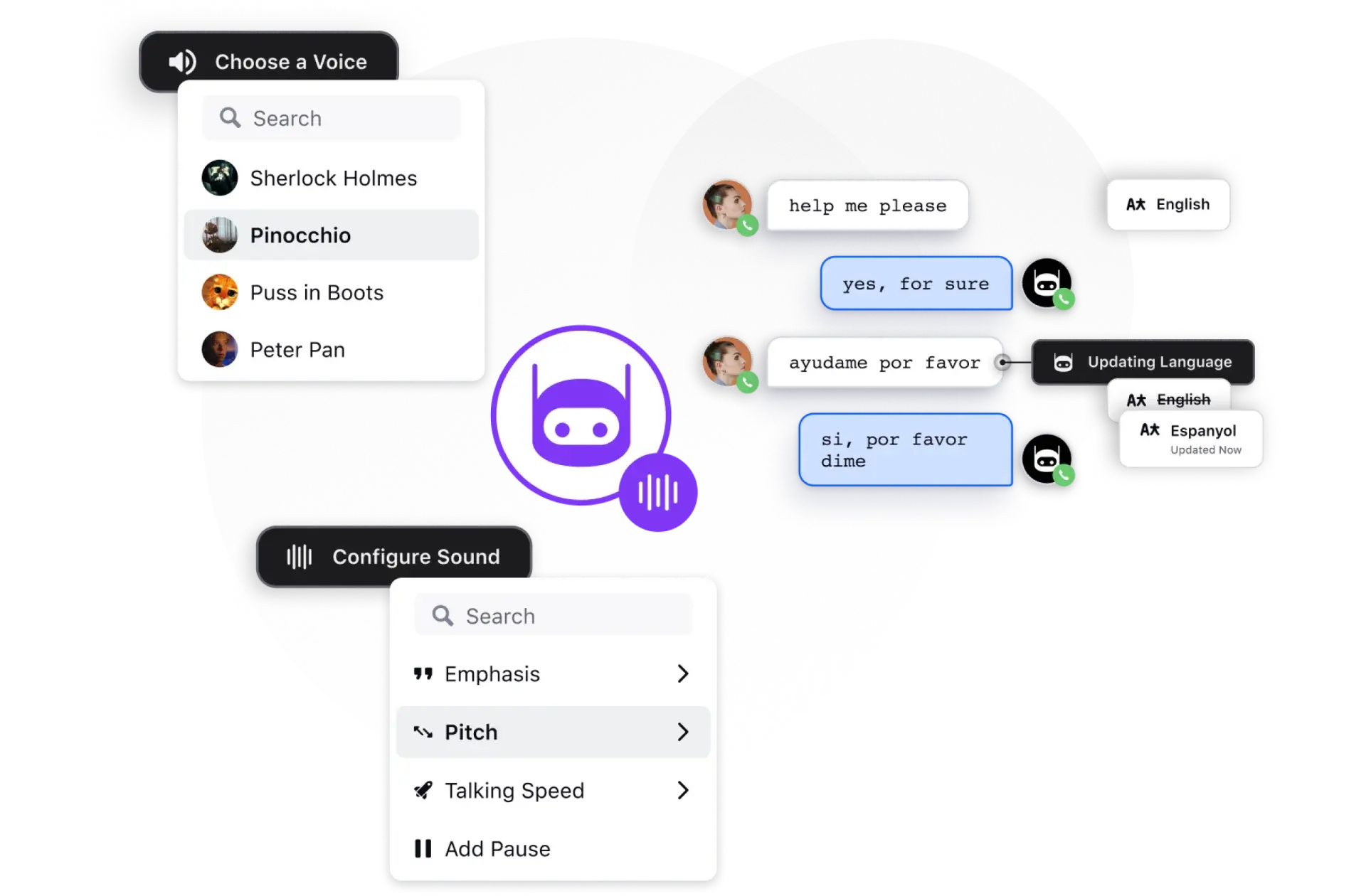
3 types of chatbots
There are three major types of chatbot software, categorized by their level of sophistication and purpose. Let’s take a detailed look at each of them.
1. Rule-based chatbots
Rule-based chatbots (or decision-tree chatbots) use if-then logic to formulate follow-up questions with predetermined options until customers are provided with reliable solutions.
This chatbot analyzes keywords in a message based on predefined rules to understand the query and provide a relevant response. They are designed to include synonyms and semantically similar keywords as well.
You can use rule-based chatbots for task-specific queries like placing an order, checking delivery status or collecting agent feedback.
2. AI-powered chatbots
AI-powered chatbot solutions use machine learning (ML) and NLP to understand customers’ language, intent and sentiment behind a message to provide personalized, human-like interactions.
Popular examples of AI chatbots are virtual agents like Amazon’s Alexa, Apple’s Siri and Google Assistant. They can study customer patterns and tend to be more conversational and personalized.
A good AI chatbot can also categorize customer interactions by complaints, leads, inquiries and compliments — helping your support team streamline workflows and prioritize customer messages that require an immediate response.
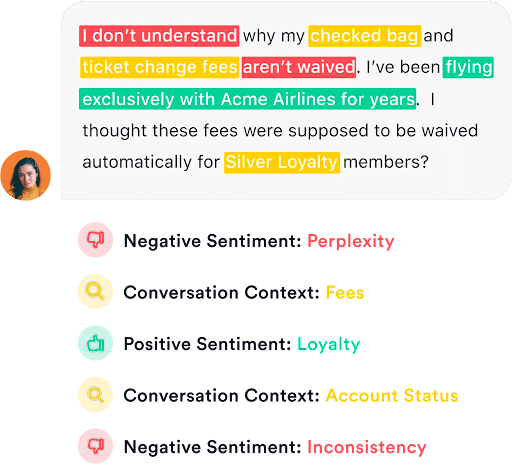
Learn more: How Conversational AI helps brands be human at scale
3. Hybrid chatbots
Hybrid chatbots, like rule-based chatbots, are simple to implement but smart like AI chatbots. They execute conversation flows based on predefined rules while understanding the intent of customers' messages.
Also, hybrid chatbots allow ML integrations to aid areas where a rule-based approach is difficult to create or implement. For example, internet providers may use hybrid chatbots to diagnose network connectivity.

How to choose the right chatbot for your business
Selecting the right chatbot for your business is a critical decision that can impact customer satisfaction, operational efficiency and overall success. Here are essential steps to guide your choice:
Identify your goals: Begin by defining your objectives — do you need a chatbot for customer support, lead generation or sales, or is it for some internal process like HR or IT support? Understanding your needs properly helps make the selection process much easier.
Understand your audience: Know your target audience's preferences and behaviors. Consider the channels they use most frequently and the type of interactions they expect with a chatbot and select a solution that aligns closely with those preferences.
Choose the type of chatbot: Decide between rule-based and AI-powered chatbots. Rule-based bots such as FAQ chatbots, follow predefined scripts, suitable for simple tasks. AI-powered bots use machine learning and natural language processing for dynamic interactions and aid in improving customer self-service for even complex queries.
Analyze the solution’s ease of configuration: Chatbots need to be highly versatile and configurable, which means setting up or modifying a chatbot should not be difficult or time-consuming. The best choice would be to go for no-code chatbots, that employ user-friendly drag-and-drop workflow editors — helping you set up and deploy your chatbot in minutes.
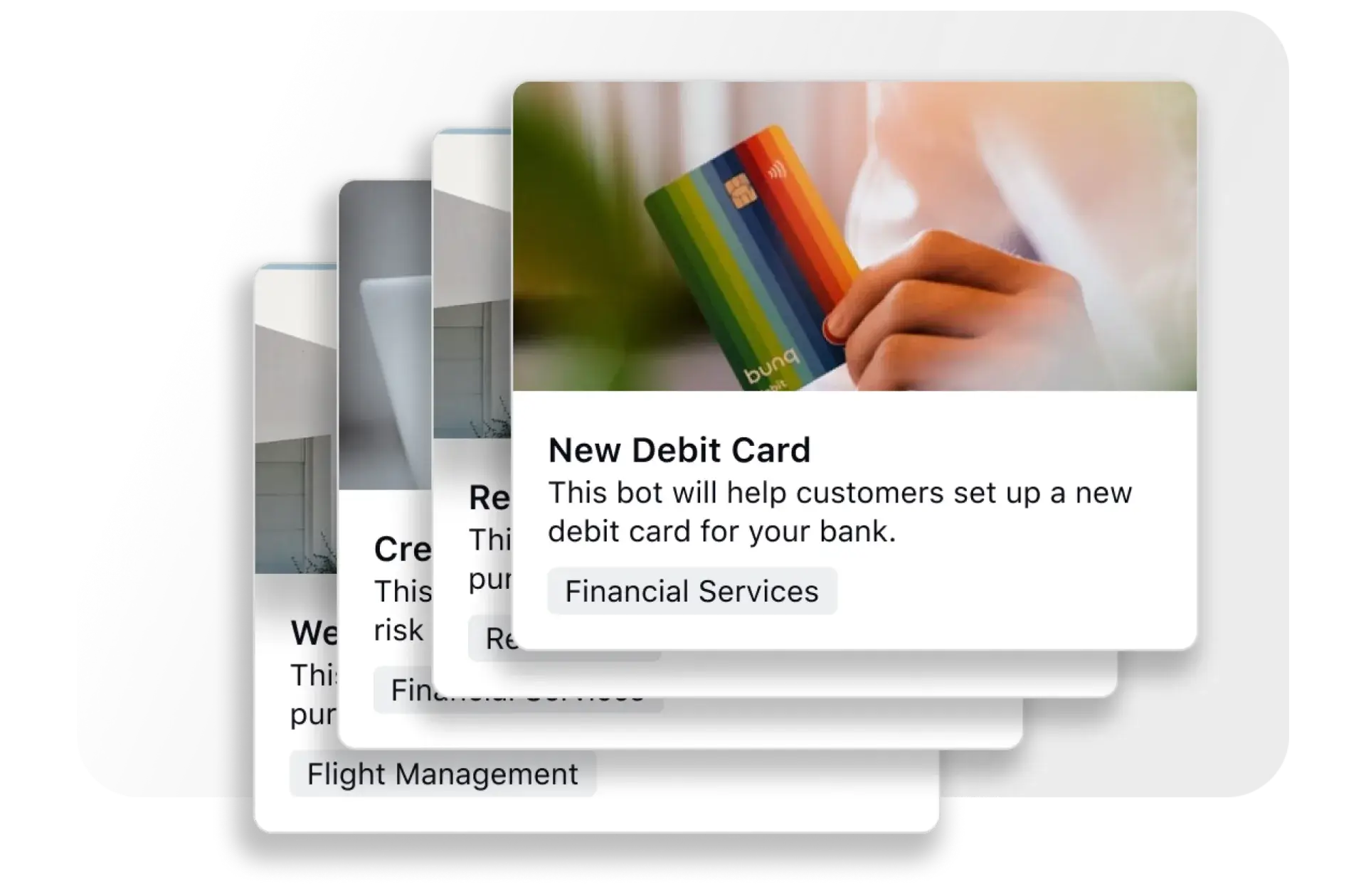
Ease of configuration also includes the following factors:
The effort it takes to deploy your chatbot across multiple channels
Customizability to maintain brand compliance (especially for chatbots on live chat)
Scalability across different regions and languages

Evaluate integration capability: Your new chatbot solution must seamlessly fit into your existing support infrastructure and work with solutions such as databases and contact center CRM. Ensure your chatbot supports quick and easy integration with these platforms to ensure maximum value and efficiency.
Ensure easy testing and training: For AI-powered chatbots, implement a solution that allows you to test and train the chat models effortlessly. Regular training and updates ensure that your customer always gets the most updated info and with high accuracy, improving your first contact resolution rate.
Check for high security and compliance: Since chatbots might collect sensitive personal data from your customers, ensure the chatbot solution you choose also complies with relevant data privacy regulations (e.g., GDPR) and provides strong security measures to protect sensitive information.
Opt for analytics and reporting: Most chatbot platforms also provide reporting capabilities to understand and analyze customer conversations. If it isn’t available by default, make sure you opt for an add-on that provides at least basic analytics capabilities to track performance, identify bottlenecks and continuously improve user experiences.

Limitations of using chatbots
Although modern-day chatbots are powerful and versatile, they still have a few shortcomings that affect their adoption and usage. Here are some of the limitations of chatbots:
Security concerns: Mishandling or mismanaging sensitive customer data is probably the biggest risk associated with chatbots — and these situations can quickly escalate to security risks if not properly configured.
Limited understanding: Chatbots may struggle with nuanced or complex inquiries, lacking human comprehension. They might also struggle with language barriers, affecting communication with non-English-speaking customers.
Cost and complexity: Creating and training sophisticated chatbots can be expensive and highly technical. Ongoing updates and improvements require resources, manpower and expertise — all of which will hinder normal support operations.
Dependency on data: Chatbots rely heavily on accurate and up-to-date data sources to deliver engaging customer conversations, making data integration crucial.
Lack of human touch: Chatbots lack emotional intelligence, hindering their ability to provide empathetic responses. This lack of emotions can make users feel even more frustrated if the chatbot also fails to understand or provide relevant answers, worsening the situation.
Examples and use cases of using chatbots for businesses
Chatbots are proving to be invaluable across various industries as a powerful solution to improve efficiency and customer satisfaction. Let’s read about a couple of examples where chatbots came to the rescue and simplified support operations for businesses.
H&M
H&M, a global fashion brand, faced the challenge of helping customers discover and select outfits more efficiently in an era of online shopping.
The solution? They launched the "H&M Chatbot" on the popular messaging app Kik. This chatbot serves as a virtual stylist, assisting users in finding clothing items and creating stylish outfits based on their preferences, style and occasion. Users can simply chat with the bot, share their fashion preferences and receive personalized outfit recommendations.
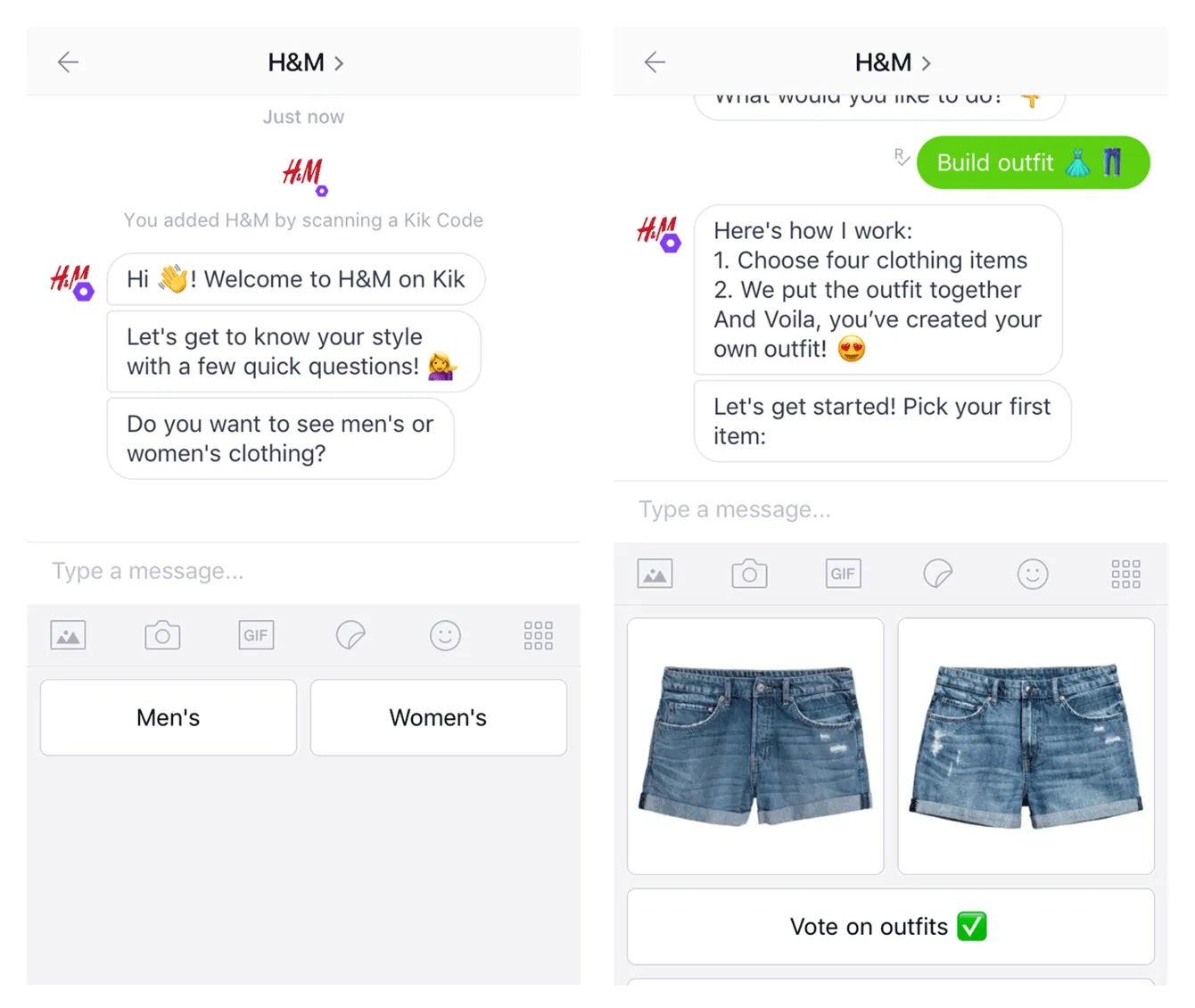
H&M significantly improved user engagement and customer satisfaction by providing tailored fashion advice and simplifying the shopping process. This innovative use of chatbots not only enhanced the online shopping experience but also drove an increase in online sales for H&M.
Bank of America
Bank of America recognized the need to provide its customers with more convenient and proactive financial support. They wanted to empower users with a virtual assistant to handle various banking tasks efficiently and offer financial advice.
To solve for this shortcoming, Bank of America introduced "Erica" — an AI-powered chatbot and financial assistant. Erica can perform tasks like checking account balances, making payments, transferring funds and even providing personalized financial advice. Customers can interact with Erica via the bank's mobile app or website, making banking tasks easier and more accessible.
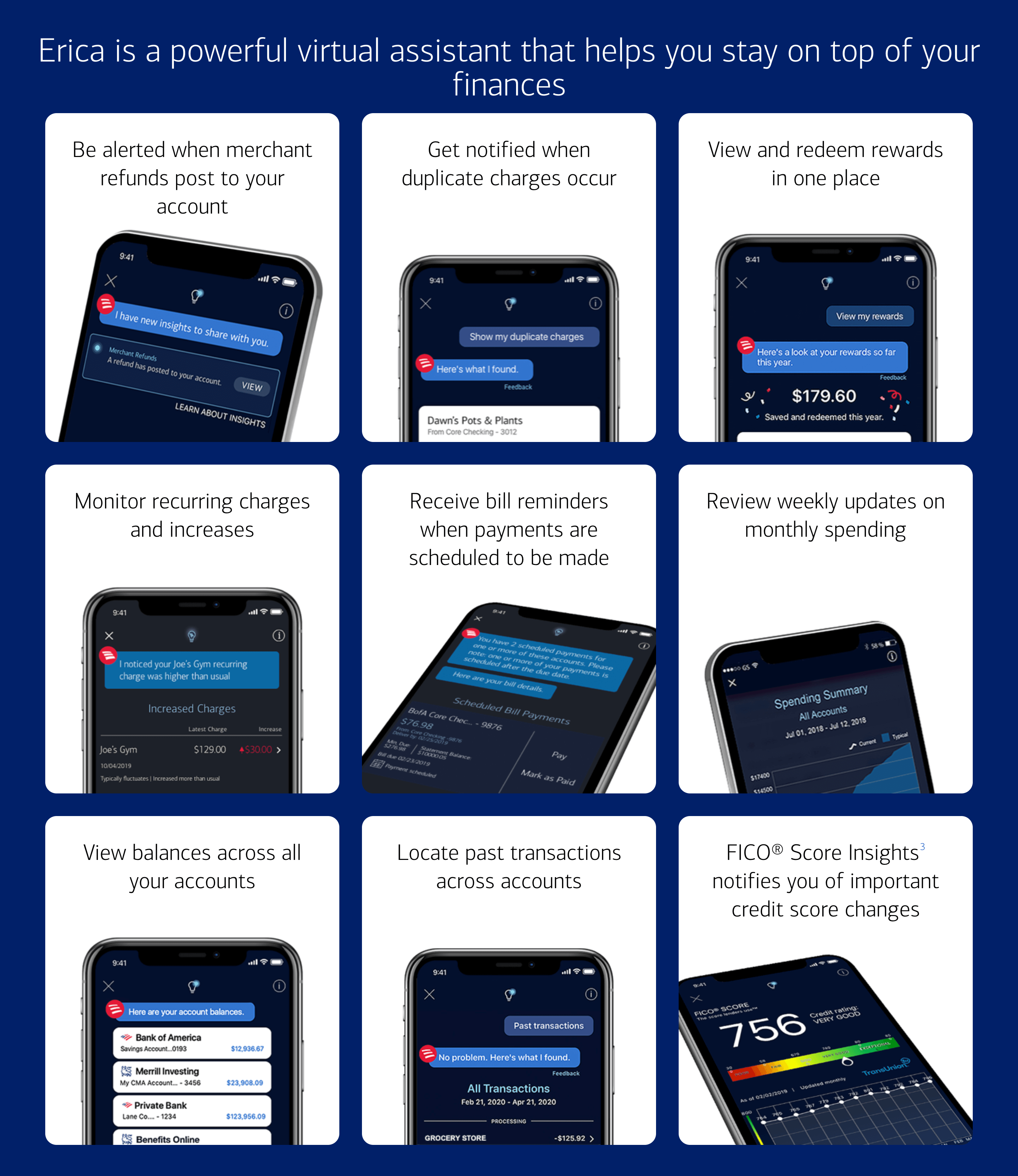
Erica has now proven to be a game-changer in the banking industry. The bot’s proactive suggestions, based on user spending patterns, have helped customers make smarter financial decisions, improve their financial literacy, and manage their accounts more effectively.
Mobily
Mobily, a prominent telecom company, had struggled with high customer service demand while being low on resources and manpower, creating a bottleneck in performance that prevented them from providing the best customer service experiences. This bottleneck further led to customer frustration and higher costs.
Their focus was only on one goal — implementing a chatbot platform that can handle routine customer inquiries, automate responses and provide 24/7 support.
The solution? Sprinklr Service.
With Sprinklr’s sophisticated conversational AI platform, Mobily built a chatbot that improved customer satisfaction, reduced costs and increased efficiency — transforming customer service in the telecom industry. In fact, Sprinklr Service was so successful in increasing efficiency that it brought their first response time from 20 minutes down to six seconds — a 99.6% improvement in average first response time across their 20+ active social channels.
Sprinklr’s Conversational AI and Bots, powered by an industry-leading 9-layer AI engine, ensure seamless support to every customer. And as the world’s only unified customer experience management (Unified-CXM) platform, Sprinklr allows you to:
Handle multiple, changing topics with smart automation: With smart dialog automation, Conversational AI can resolve multiple queries within a single interaction or even switch topics completely mid-conversation — responding in ways that make customers forget they’re not talking to a person.
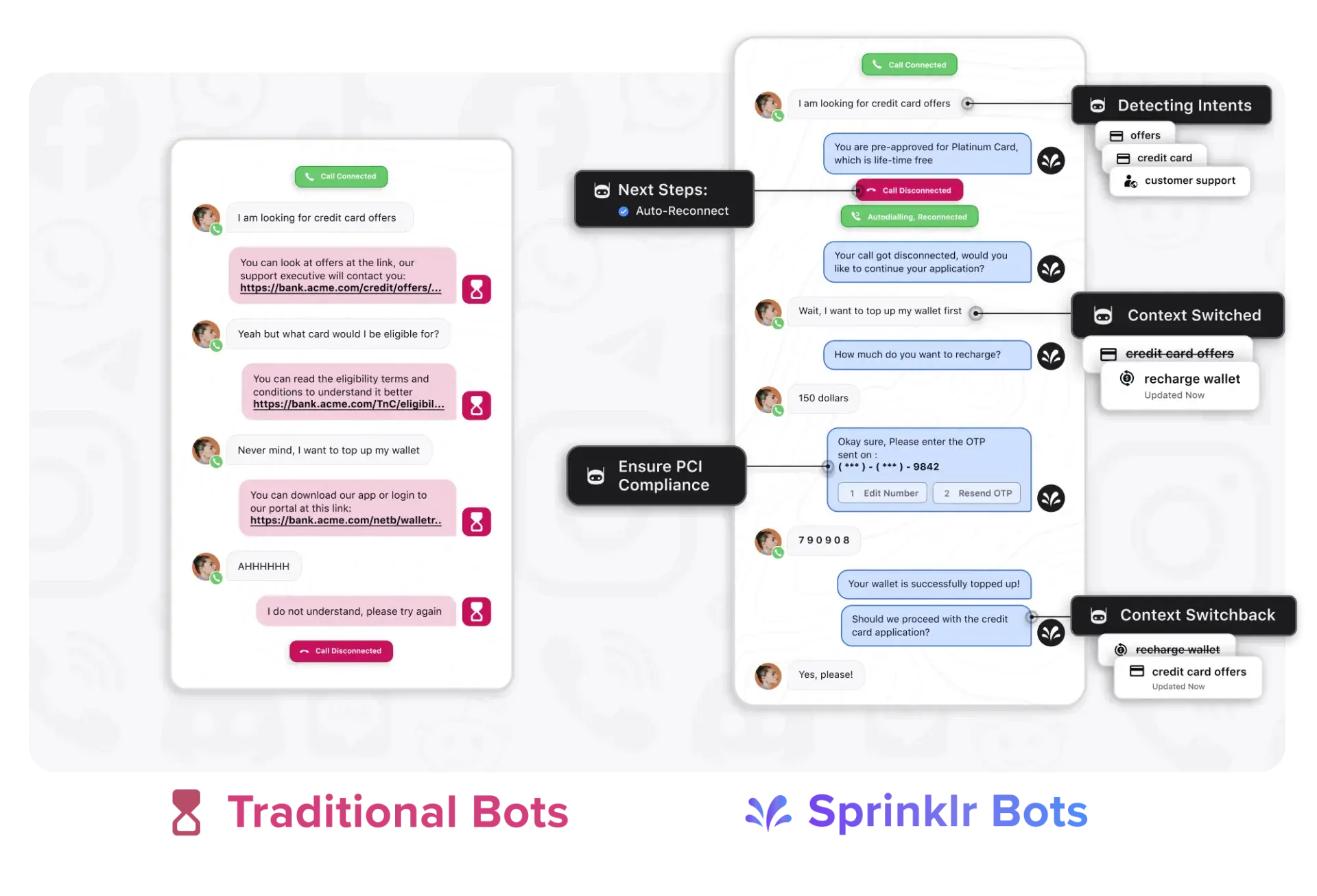
Deploy bots across languages: Traditional bots only handle one communication channel at a time — which means redundant effort and costs if you offer chat, social media, and messaging support. Sprinklr Conversational AI creates a single chatbot flow you can easily customize for each channel.
Manage all channels with a single bot: Sprinklr Conversational AI analyzes your customer data, identifying the top categories and intents with the biggest impact on your business — eliminating the human guesswork in deciding which conversational flows to build.
Discover the top reasons why customers contact your brand: Sprinklr Conversational AI analyzes your customer data, identifying the top categories and intents with the biggest impact on your business — eliminating the human guesswork in deciding which conversational flows to build.
Continuously improve the accuracy of your AI bots: Conversational AI pulls customer data from more than 30 digital and traditional channels, 500 business-specific models, and 100 million data training points — providing the best accuracy at resolving cases at scale and making each automated response more precise and helpful.
Still unsure if Sprinklr can help your business boost efficiency and delight your customers? Sign up for a fully functional demo of Sprinklr Service and experience it firsthand!
Frequently Asked Questions
The three widely used types of chatbots are:
Rule-based chatbots
AI-powered chatbots
Hybrid chatbots
Thank you for contacting us.
A Sprinklr representative will be in touch with you shortly.
Contact us today, and we'll create a customized proposal that addresses your unique business needs.
Request a Demo
Welcome Back,
No need to fill out any forms — you're all set.







